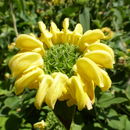en
names in breadcrumbs


Phlomis fruticosa, the Jerusalem sage,[1] is a species of flowering plant in the family Lamiaceae, native to Albania, Cyprus, Greece, Italy, Turkey, and countries of the former Yugoslavia.
It is a small evergreen shrub, up to 1 m (3 ft) tall by 1.5 m (5 ft) wide. The sage-like, aromatic leaves are oval, 5–10 cm (2-4ins) long, wrinkled, grey-green with white undersides, and covered with fine hairs. Deep yellow, tubular flowers, 3 cm in length, grow in whorls of 20 in short spikes in summer.[2]
The specific epithet fruticosa means "shrubby".[3]
It is popular as an ornamental plant, and has gained the Royal Horticultural Society's Award of Garden Merit.[4][5]
As a garden escape, it has naturalised in parts of South West England.[6]
It is listed as deer resistant, hardy in zones 7 to 11, and tolerant of a range of soil types.
Phlomis fruticosa, the Jerusalem sage, is a species of flowering plant in the family Lamiaceae, native to Albania, Cyprus, Greece, Italy, Turkey, and countries of the former Yugoslavia.
It is a small evergreen shrub, up to 1 m (3 ft) tall by 1.5 m (5 ft) wide. The sage-like, aromatic leaves are oval, 5–10 cm (2-4ins) long, wrinkled, grey-green with white undersides, and covered with fine hairs. Deep yellow, tubular flowers, 3 cm in length, grow in whorls of 20 in short spikes in summer.
The specific epithet fruticosa means "shrubby".
It is popular as an ornamental plant, and has gained the Royal Horticultural Society's Award of Garden Merit.
As a garden escape, it has naturalised in parts of South West England.
It is listed as deer resistant, hardy in zones 7 to 11, and tolerant of a range of soil types.

